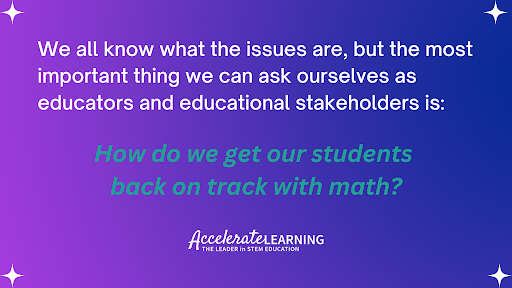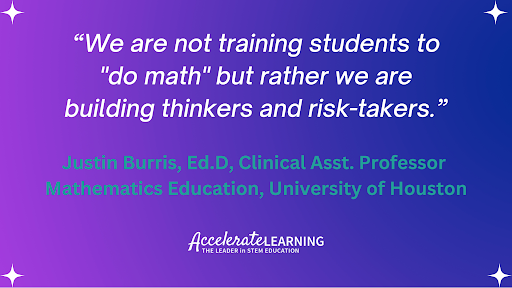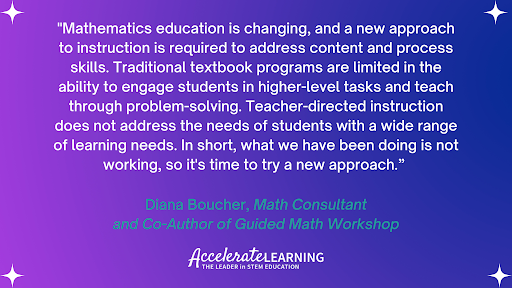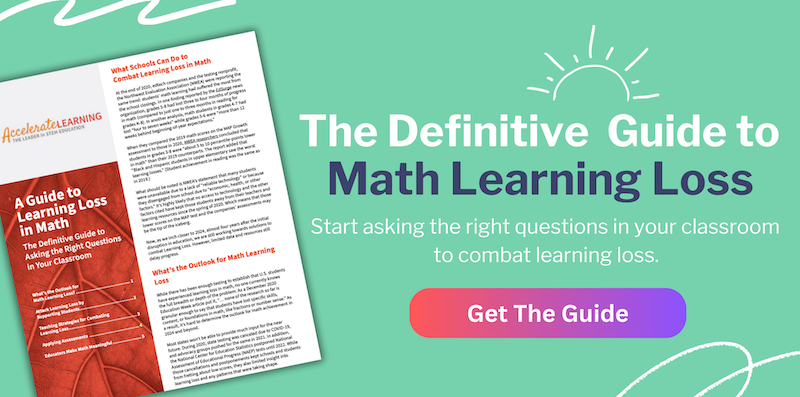How to Address Math Learning Loss
Even though most of us would rather leave March 2020, and the months that followed, back in the past—as a nation, we are still feeling the effects of Covid learning loss. In fact, for the first time in the history of assessment tracking, math scores dipped.
Lower test scores are not a surprise. The pandemic changed the world, especially the world of education. The effect of one and half years of distance and/or hybrid learning, along with pandemic-related obstacles, such as absences due to illness, and the overall unorthodox year of instruction had a direct effect on student learning and the dip in test scores.
However, low test scores on a national level is more than just students struggling in math. Students are missing the essential skills needed to get on grade level. They have fallen behind—and what this means for teachers is that they need to now dedicate more classroom instructional time towards academic recovery.

There’s no one solution that will instantly reverse the effects of learning loss. Pandemic learning changed the way students learn and approach learning. However, rebounding and finding ways to engage students in meaningful and sophisticated thinking is the only solution. It’s the goal we strive towards. We want to help you regain momentum and strive for student success and better test scores, so we’re sharing some strategies and approaches to learning to support you and your students.
Changing the Way Students Think About Math
One of the biggest challenges of teaching math is the perception attached to what it is to be good at math. Often times we associate speed in completing problems as an indicator of how strong a student’s math skills are. That’s far from the truth. Students’ processing speeds vary, and the amount of time one takes to complete a problem doesn’t directly relate to their ability to master a concept.
Not only do we need to approach new ways of teaching math, but also new ways of thinking about math. We also need to move from the notion that people are simply not math people. Almost every person who doesn’t consider themselves a math person can relay a specific story about how at some point in their life—they did not succeed in math class, and that label, whether self-imposed or given by others, changed their perceptions of who they were as math thinkers. Any—and—everyone can be a math person. Our brains do not stop learning. Brains are malleable in the sense that the brain is able to learn, adapt, and acquire new information at any age. Math isn’t blocked off to anyone.

New Ways Vs. Old Ways of Teaching Math
Traditional ways of teaching math are outdated in the modern classroom. Students need access to material and concepts that align with the direction of their world and help them build the 21st-century skills that will serve them now and in the future.

Worksheets, sit and get, drill and kill–these approaches are not going to work for students already struggling with math and straggling behind peers. Students benefit from interactive lessons that engage them in inquiry, creating a connection between what they are learning and what they see happening in the world around them. Not only does this make math more accessible, but it also allows increased interest and engagement. Students will be more invested in their learning if they see how it can be used in real-life applications.
One surefire way to get students invested is by making math more interactive. Interactive lessons and activities allow students to contribute in different ways, apply knowledge and skills, and it allows them to move around the classroom—something we don’t typically associate with math class, but we should.
Increasing Engagement with Interactive Math Activities
Many activities and lessons can be tweaked to incorporate a more interactive math experience for students. These activities we listed below will not only appeal to your general education students but will also assist multilingual learners and students with learning disabilities in building up skillsets and getting the most out of math class. So, get students out of their seats and watch them learn!
Project-Based Learning (PBL) - Introduces students to a challenge that requires collaboration in order for success. Project-based learning has a place in every classroom and provides students the opportunity to interact with peers as they hone their research skills and solve open-ended questions. As a student-centered activity, PBL promotes inquiry, investigation, and, most importantly, fun.
Project-based learning has the potential to work for every student, as it provides an interdisciplinary approach to learning. This gives students with different interests and skill sets the opportunity to apply their knowledge in order to meet an objective, contributing to their team’s overall success.
Math Journals - Notes, questions, practice problems, and much more to serve as a visual collection of a student’s work and problem-solving process. Using a notebook or binder, this activity allows students to utilize their creative and artistic skills and house information in one resource. Students can glue, color, and decorate their journals to appeal to their preferences in material layout. Math journals allow students to organize, clarify, and reflect on their thinking. They can also use their journals to record their thinking and show their strategy for finding the solution. Teachers can also offer the option of a digital platform, like Google slides or Evernote, to record and house information.
Math Journals also provide an excellent option for formative assessments. Teachers can use an individual’s notebook to assess their understanding and evaluate the strategies used. It also provides teachers with a general understanding of how students are grasping the material and demonstrating mastery in math class.
CRA - Although Concrete, Representational, and Abstract (CRA) is an instructional framework for teaching math, it offers students an interactive way to learn math and provides teachers a wonderful way to scaffold material. CRA focuses on developing a deep understanding of a concept and allowing students to see patterns and relationships through the different ways they interact with it. It can be configured for whole class, small group, and individual instruction.
Math Stations - In stations, students are to perform and complete a specific activity or task. They can be unified in theme or independent activities—the choice is really yours. Math stations offer flexible opportunities for students to learn at their own pace.
There’s nothing wrong with tried-and-true. Groups, stations, and anything that allows students to actively participate in their learning will have the most impact on them. Teachers can use math stations to scaffold learning, differentiate instruction, and challenge students. (This is also a great way to explore CRA!)
Math Word Wall - Building math vocabulary is an essential part of learning mathematics. Being able to use vocabulary empowers students and reinforces their self-perception of being good at math. Word Walls works as an anchor chart to remind students of foundational math vocabulary and concepts.
Elementary teachers can make this activity interactive by having students illustrate the images used for the word wall. Students can conduct gallery walks and even vote on specific student work to be displayed in the classroom. Another way teachers can use word walls (or even any anchor charts and posters) is to arrange them on different walls in the classroom. Teachers can then ask students questions and have them move to the wall where the corresponding vocab word or poster is hanging.
You may also want to consider adding these fun, interactive ideas to your classroom: how to teach math through play or gamification vs. game-based learning - how to use both.
In STEMscopes Math, our lessons are filled with hands-on, interactive and fun activities that ignite student learning including the activities listed above. Want to give some of our classroom activities a try?
Using Assessments to Measure Student Growth
The word assessment is often times associated with standardized testing. However, assessments are more than just district or state-level testing. Teachers use assessments and evaluations to track student progress, growth, and mastery. They analyze the data to determine how well students are responding to the material, how effective their teaching practices are, the need for intervention and differentiation, and much more.
Districts use district-wide benchmark testing to serve as a formative assessment that helps with teacher preparation and planning. It can also be used as a summative assessment in the right context.
Here are the three general types of assessments:
FORMATIVE ASSESSMENTS - Serve as a continuous collection of data in math instruction. Formative assessments can be as informal or formal as a teacher chooses. These are low stakes and low stress for students. Formative assessments track where students are and monitor their acquisition of new knowledge and skills.
Examples of formative assessments include:
- Exit ticket (i.e., post-it parking lot)
- Thumbs up or down (check for understanding)
- Homework
- Discussion questions
- Quizzes
SUMMATIVE ASSESSMENTS - Serve as a way to evaluate student learning and students’ ability to demonstrate mastery of specific skills or certain subject matters. Summative assessments are compared against state standards and district benchmarks.
Examples of summative assessments include:
- Midterms or Final exams
- Final essay
- Unit test
- Final project
STANDARDIZED TESTING - Serves as the ultimate indicator of student learning, growth, and demonstration of mastery in the US education system. In standardized testing, students respond to the same set of curated questions. These questions are scientifically normed in order to make comparisons between students and establish grade-level standards and benchmarks. These tests typically consist of multiple-choice and true/false questions.
Although the majority of standardized tests are machine graded, some also include a writing portion, which requires a physical grader and can be open to subjective interpretation. Standardized testing helps us with gauging the levels of student achievement.
Tools and Resources to Combat Math Learning Loss
One of the best ways to ensure students are provided opportunities to rebound after covid learning loss is to invest in resources that develop weak and missing skill sets. Given the impact of learning loss so far, many experts suggest supplementing regular instruction with tutoring sessions to help expedite academic recovery. This will allow teachers to focus on the curriculum and meet grade-level expectations. Tutoring services, such as Math Nation’s On-Ramp, can help students and teachers by providing dedicated time to academic recovery without taking up too much class time.
A New Path Forward
Even before the pandemic, the way we’ve approached teaching and learning math wasn’t working. As a nation, we’ve been lagging behind in math on a global level for some time now, and it took a pandemic to really highlight the shortcomings of our math instruction.
This is an opportunity to implement a new way of teaching math—a new way forward. This is our chance to reshape the way students learn and interact with math.
Let’s get our students back on track and on the road to academic recovery.
At Accelerate Learning, it's our mission to provide the most effective digital STEM curricula and resources that empower teachers and enable students to develop problem-solving, innovation, and critical thinking skills. Our math solutions, STEMscopes Math and Math Nation, are proven STEM-based programs in helping students improve their literacy and competency in math every day—leading to increased student engagement, higher teacher satisfaction and better test scores.



